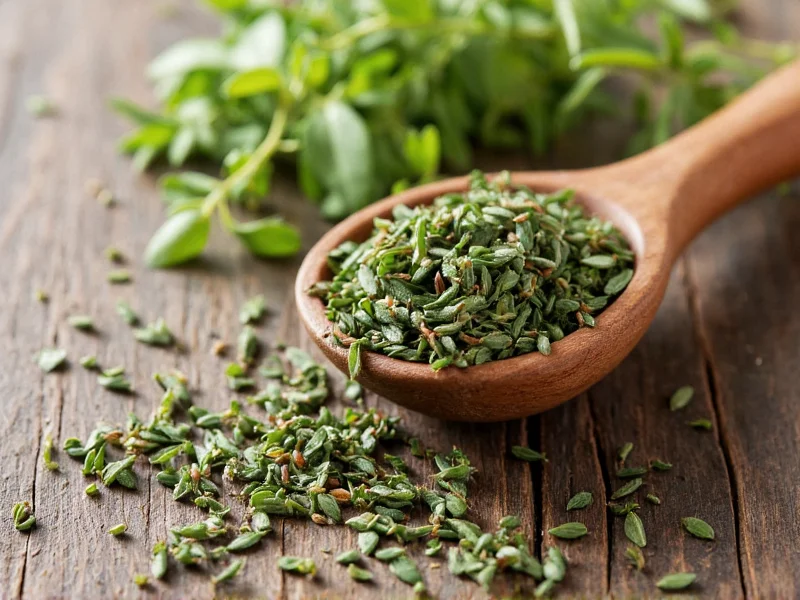Understanding what thyme tastes like requires exploring its complex flavor profile that makes it indispensable in kitchens worldwide. This versatile herb delivers a unique combination of earthiness, subtle mintiness, and delicate lemon undertones that enhance both simple and sophisticated dishes. Whether you're wondering how would you describe thyme taste to someone unfamiliar or seeking to understand what does fresh thyme taste like versus dried, recognizing these flavor dimensions helps maximize its culinary potential.
The Complete Flavor Profile of Thyme
Thyme's taste experience unfolds in distinct layers. The initial impression is earthy and slightly floral, followed by subtle mint and lemon notes that dance across your palate. A gentle peppery warmth lingers in the finish, making thyme more complex than many other common herbs. This multidimensional profile explains why professional chefs consider it a foundational herb in French, Mediterranean, and Middle Eastern cuisines.
The specific taste characteristics vary depending on whether you're using fresh or dried thyme. Fresh thyme provides brighter citrus notes and a more delicate floral quality, while dried thyme intensifies the earthy, woody elements and develops subtle camphor-like qualities. Understanding these differences is crucial when following recipes that specify one form over the other.
Thyme Compared to Similar Herbs
Many home cooks wonder what herb tastes similar to thyme when substitutions become necessary. The following comparison clarifies how thyme relates to other common herbs:
| Herb | Flavor Profile | Similarity to Thyme |
|---|---|---|
| Thyme | Earthy, minty, lemon notes, peppery finish | Reference standard |
| Rosemary | Pine-like, resinous, more intense | Moderate (use 1/2 amount as substitute) |
| Oregano | Peppery, slightly bitter, robust | Moderate (better for Mediterranean dishes) |
| Marjoram | Sweeter, milder, floral | High (use equal amount as substitute) |
| Savory | Peppery, pine-like, herbal | High (particularly summer savory) |
Factors That Influence Thyme's Flavor
Several elements affect how thyme tastes in your dishes:
- Varietal differences: Common thyme (Thymus vulgaris) offers the classic flavor profile, while lemon thyme provides pronounced citrus notes, and caraway thyme delivers distinctive spice undertones
- Growing conditions: Soil composition, sunlight exposure, and water availability impact the concentration of essential oils that create thyme's characteristic taste
- Harvest timing: Thyme picked just before flowering contains the highest concentration of flavor compounds
- Preparation method: Whole sprigs release flavor gradually during cooking, while minced leaves deliver more immediate impact
Culinary Applications That Showcase Thyme's Flavor
Knowing what does thyme taste good with transforms ordinary dishes into extraordinary creations. Thyme's flavor profile complements:
- Proteins: Particularly effective with chicken, lamb, and fish where its earthiness balances rich flavors
- Vegetables: Enhances roasted root vegetables, mushrooms, and tomatoes by adding complexity
- Sauces and stocks: Forms part of the French "bouquet garni" that builds foundational flavors
- Bean dishes: Complements legumes in dishes like cassoulet and minestrone
When cooking with thyme, remember that dried thyme requires about half the quantity of fresh thyme due to its concentrated flavor. For delicate dishes, remove woody stems before serving as they become unpleasantly tough during cooking.
Common Misconceptions About Thyme's Taste
Several misunderstandings persist about how thyme tastes. Many believe thyme tastes overwhelmingly strong, but properly used, it provides subtle background complexity rather than dominating other flavors. Others confuse thyme with oregano, though thyme's flavor is more delicate and less peppery. Some think dried thyme tastes identical to fresh, when in reality the drying process transforms its flavor profile significantly.
Maximizing Thyme's Flavor Potential
To fully appreciate what thyme tastes like in your cooking:
- Add fresh thyme early in cooking for soups and stews to allow flavors to meld
- Use dried thyme in rubs and spice blends where its concentrated flavor shines
- Pair lemon thyme varieties with seafood and poultry for enhanced citrus notes
- Combine thyme with complementary herbs like parsley and bay leaf for balanced flavor profiles
Understanding thyme's distinctive taste characteristics empowers you to use this versatile herb more effectively. Whether you're exploring what does thyme taste like in soup or considering how would you describe thyme taste to fellow cooks, recognizing its earthy foundation with minty-lemon nuances helps you create more nuanced and flavorful dishes. This knowledge transforms thyme from a simple ingredient into a powerful culinary tool that elevates everything it touches.
Frequently Asked Questions
Does thyme taste like oregano?
No, thyme and oregano have distinctly different flavor profiles. Thyme offers a more delicate, earthy flavor with subtle mint and lemon notes, while oregano delivers a stronger, more peppery taste with pronounced bitterness. Though both belong to the mint family, they're not interchangeable in most recipes without altering the dish's character.
Is fresh thyme stronger than dried thyme?
Actually, dried thyme is more concentrated in flavor than fresh thyme. You typically need about three times the amount of fresh thyme to match the flavor intensity of dried thyme. Fresh thyme provides brighter, more floral notes while dried thyme develops deeper, woodier characteristics with subtle camphor undertones.
Why does my thyme taste bitter?
Thyme can taste bitter when overcooked, especially if added too early in the cooking process for delicate dishes. The woody stems also become unpleasantly bitter when cooked for extended periods. To prevent bitterness, add fresh thyme toward the end of cooking for quick dishes, and always remove stems before serving. Using excessive amounts or old, degraded thyme can also create bitter notes.
What does lemon thyme taste like compared to regular thyme?
Lemon thyme features a much more pronounced citrus flavor than regular thyme, with distinct lemon notes that dominate its profile. While regular thyme has subtle lemon undertones, lemon thyme delivers a bright, refreshing citrus character that works exceptionally well with seafood, poultry, and vegetable dishes where a stronger lemon flavor is desired without adding actual lemon juice.











 浙公网安备
33010002000092号
浙公网安备
33010002000092号 浙B2-20120091-4
浙B2-20120091-4